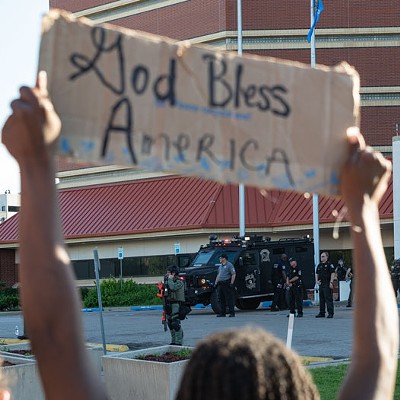
Daily, Yukon resident Angie Secrest checked social media for updates on the growing campaign to protect water sources and sacred land. Vivid images of objectors standing in the path of oil pipeline construction near the Standing Rock Sioux Reservation in North Dakota filled her timeline.
She examined video and photos of peaceful action, prayer and unity as North American indigenous peoples and activists of all ages and backgrounds supported Standing Rock Sioux tribe.
She also witnessed law enforcement’s escalating militarized attempts to keep thousands of objectors from impeding Energy Transfer Partners' progress on Dakota Access Pipeline (DAPL) as the controversial 1,172-mile-long project neared completion just upstream from tribal land and, according to tribal leadership, threatened natural resources and sacred tribal sites.
As police employed water cannons, tear gas, rubber bullets, dogs and concussion grenades against activists, many U.S. military veterans — including Secrest, a retired U.S. Army medic — felt called to action.
“The videos are graphic. The images are graphic,” she said. “It looks like a war scene. As a combat veteran, I’ve been to war. This doesn’t look like anything I want to see on American soil.”
Last week, cellphone in hand, Secrest clicked through social media and pulled up a photo a journalist posted a day earlier. Lights atop a police water cannon vehicle silhouetted a single activist standing with their arms at their sides. Water arched through the subfreezing night air as it doused the peaceful objector.
“Does he look violent?” Secrest asked as tears filled her eyes. “He is just standing there. It is wrenching at my heart. These are our people.”
On Nov. 20, Secrest discovered the grassroots and social media-fueled event Veterans Stand for Standing Rock. Former Marine Michael A. Wood Jr. and screenwriter and activist Wesley Clark Jr., along with more than 2,000 veterans, “self-deployed” as a peaceful, unarmed militia to support dozens of tribes and thousands of DAPL objectors camped around the stalled Dakota Access Pipeline construction site, located near the Cannonball River and Missouri River at Lake Oahe, North Dakota. The pipeline crosses unceded Sioux territory (under the 1851 Treaty of Fort Laramie) and abuts Standing Rock Indian Reservation, the sixth-largest reservation in the nation with a land area of more than 3,500 square miles.
Secrest quickly typed an email pledging her support to Veterans Stand for Standing Rock organizers. As one of the first couple hundred veterans committed to the mission and the first Sooner, she was appointed Oklahoma Regional Team Leader. The position came with duties like arranging travel and scheduling donation pickups in all 77 counties. A couple dozen Oklahoma veterans gathered into passenger vans and various vehicles Dec. 2 and caravanned to Cannon Ball, North Dakota.
“We did take an oath to stand up and protect this country, foreign or domestic,” Secrest told Oklahoma Gazette days before deploying. “I can’t speak for all veterans, but I feel like this is terrorism on American soil — look at how these people are being treated.”
Protesting the pipeline
Since April, when the Standing Rock Sioux launched its organized peaceful protest around the construction site, indigenous peoples and others around the globe have raised their voices in support of halting Dallas-based Energy Transfer Partners’ Dakota Access Pipeline construction, which could threaten natural resources and sacred land. The tribe’s protest centers on protecting the Missouri River, a primary water source for the reservation, and stopping the pipeline operator from destroying sacred ancestral sites.The tribe, which laid out its grievances in federal court, argued it was not properly consulted during pipeline surveying and permitting processes. Sunday, the US Army Corps of Engineers announced it would deny a construction easement permit for the contested pipeline section and that the company must examine alternate pipeline routes.
Hours later, Energy Transfer Partners issued a statement asserting its commitment to the project’s completion without rerouting it. Objectors, including veterans, vowed to stay put and united through the process of public input and analysis during the monthslong environmental impact process.
Dakota Access Pipeline resistence has become a showdown pitting peaceful indigenous peoples and their allies against corporate power and militarized police . It also sparked a national movement centered on protecting tribal sovereignty, the environment and basic human rights. Tribal leaders assert that the methods Energy Transfer Partners and the federal government used to approve construction of the portion of the pipeline that abuts and crosses tribal lands violates the United Nations Declaration on the Rights of Indigenous People.
The declaration, passed in 2007, states, in part, “States shall consult and cooperate in good faith with the indigenous peoples concerned through their own representative institutions in order to obtain their free and informed consent prior to the approval of any project affecting their lands or territories and other resources, particularly in connection with the development, utilization or exploitation of mineral, water or other resources.”
Objectors rally locally
The movement has grassroots support in Oklahoma City, an area home to thousands of Native Americans. The cause, along with the violence, sparked support from community members who have rallied in churches, high-traffic intersections and on state Capitol steps as they chant “Water is life” and wave “NoDAPL” posters.“It is embedded in my mind every day,” said Happy Frejo, who is of Pawnee and Seminole heritage. “I have moments where I cry at work. It hurts my heart to see our people going through this.”
Frejo was one of many to raise a megaphone and share her strong connection with the Standing Rock Sioux people during last week’s rally in downtown Oklahoma City’s Kerr Park. While standing in solidarity with the tribe and its allies, activists called for the public to divest from major financial institutions across the globe that are offering loan support to Energy Transfer Partners.
As a professional performer, several years ago, Frejo visited the Standing Rock Sioux reservation for a youth workshop. In September, she again traveled there under much different circumstances. Standing with dozens of tribes from across North America, Trejo witnessed large bulldozers carve open land as Sioux citizens wept.
“If we are going to fight for clean water, what is the next right we have to fight for?” Frejo asked.
After hearing the leader of the Standing Rock Sioux call upon all native leaders to visit opposition sites, Absentee-Shawnee Tribe Gov. Edwina Butler-Wolfe felt compelled to make the trip and traveled there on Veterans Day. She said the public might be familiar with the hashtag #NoDAPL, but it takes a trip to the frontlines to truly grasp the movement and the monthslong, and at times violent, opposition movement.
“I tell people in our Indian Country to pray for those brothers and sisters up there,” Butler-Wolfe said. “They are fighting for us down here.”
During the local Dec. 1 rally, speakers pointed out that even the safest pipelines can leak and cause damage to the environment. Numerous oil and gas pipelines crisscross Oklahoma, and most recently, a crude oil spill was reported in Cushing, one of the world’s largest oil storage hubs.
Veteran role
“I think as a veteran, the solider mentality kicks in,” Secrest said when asked how she prepared to join veterans and stand alongside thousands of Americans at the Standing Rock Sioux site. “The only difference is this is a peaceful movement. It’s not like going into war.”Since announcement of Veterans Stand for Standing Rock, event organizers stressed the nonviolent role veterans have on the frontline. Veterans hope their peaceful actions catch national media attention and a louder national cry for the pipeline’s halt.
“The reaction is unsettled,” Secrest told Oklahoma Gazette the morning after the army denied the easement. “There are those that believe this is a win, those that believe it’s a fake display for the media and those that believe it simply is history on its way to repeating itself.”
Print headline: Frontlines, Veterans stand with North Dakota’s Standing Rock Sioux tribe to protect resources and sacred lands.











